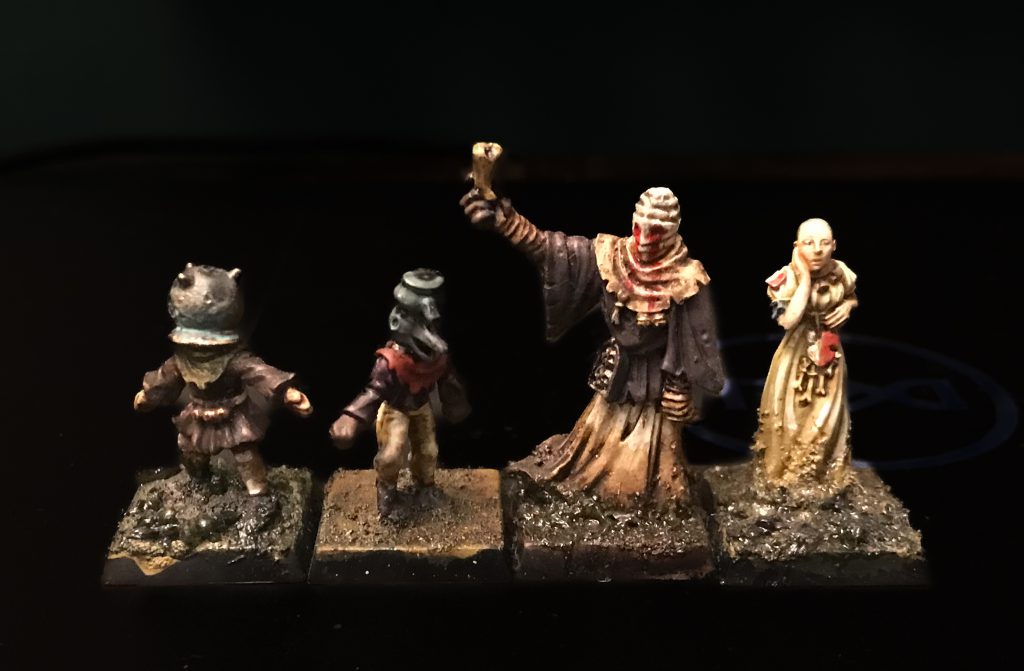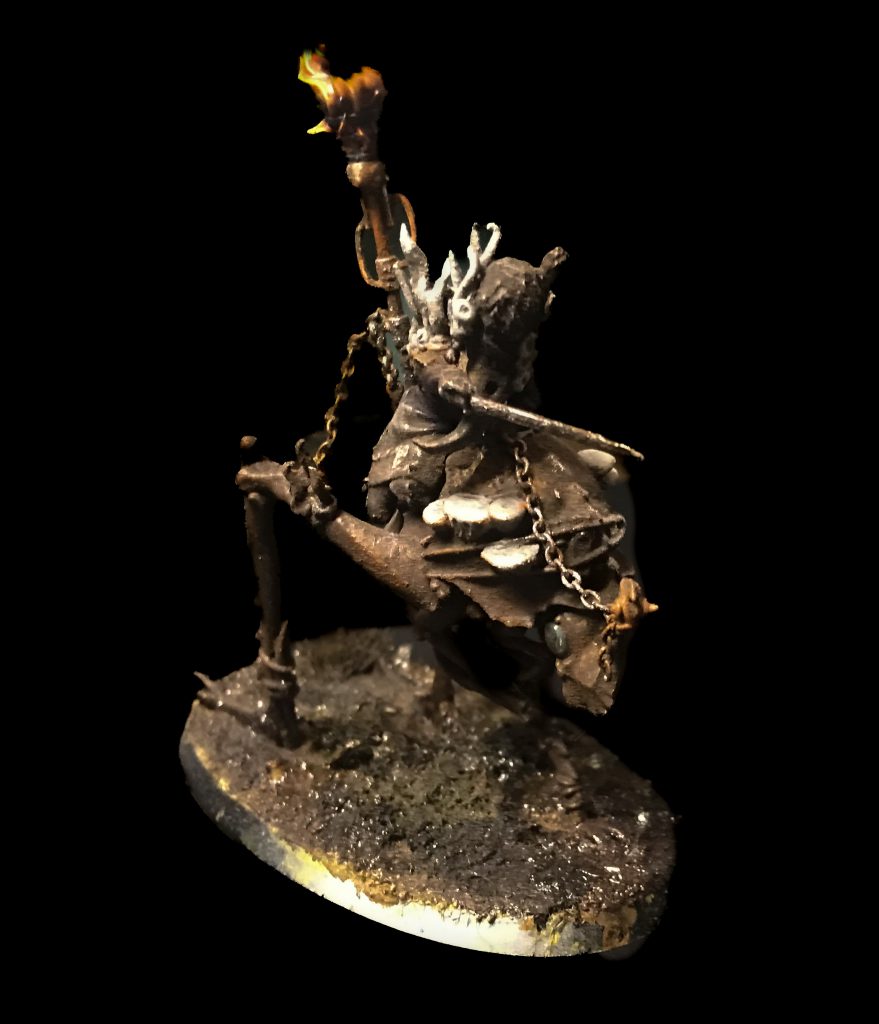Turnip 28 is with no reservations one of the most fun wargames I have ever played. We have already interviewed the creator here on the site before, so it is high time we actually talk about and recommend the game. Turnip 28 is a wargame about deranged peasants kicking each other to death in the mud, and does a better job getting a theme across with mechanics than almost any other wargame I have played. Also, the models are a ton of fun and the modelling and conversion opportunities it provides are excellent for clearing out your bits box. So let’s talk about it a bit.
Modelling
One of the first things you will notice, and one of the largest draws of Turnip 28, is that it is part of the greater Inq-28 and Blanchitsu movement. This means that the models most players use are heavily converted and covered in mud, blood, and horror. It is a very liberating space to work in as a hobbyist, because any weirdness or mistake is actually just a mutation, and if you cover it with enough slime and blood, it might even be a good looking mutation. The models you use can be as simple as some grime covered napoleonic infantrymen, or as complex as some meticulously converted and hand sculpted mutants. The lack of strict sizes for models and, until recently, the lack of official models in general, means that armies for Turnip 28 vary hugely. I have a heavily converted woodland cult army for it, but someone else could have knights with radishes for heads, or starving zombies, and they are all able to play the same game and look great on a table with each other.

The game also has huge room for terrain modelling, as swamps, woodlands, decaying buildings and rotting fence lines are a huge part of the game, terrain being arguably the most consequential part of most games. The small recommended board size, roughly 4×4 or 3×3 depending on preference, means that it is fairly easy to play in a small space, and fairly easy to make enough terrain to convincingly cover a battlefield, which is great fun.
Mechanics
Turnip 28 is built around your horrible officers and their goons. With unit’s having names like “Chaff”, “Fodder”, and “Bastards”, it is immediately clear that you are not supposed to value your units very highly, and that everyone in this world is a miserable bastard. Each unit is designed to be reasonably balanced against any other unit, and the game lacks a point system, instead determining game size by the amount of officers, or “Snobs”, present. You head officer, called a “Toff”, has 2 units of goons, and each sub-officer, or “Toady”, has 1 unit. The recommendation is a 3 snob game, which means 4 units. This keeps the game at a manageable game size, at the large end of skirmish games and the small end of army games, usually 20-40 models per side. Each turn you alternate activating your officers, who can order a unit. Units, being pathetic, horrible little men, have a chance of bungling the order and either getting a smaller effect or suffering consequences which are unique to the scenario you are playing, such as them turning on each other and eating a few models out of the unit, or getting taken by the swamps that you are fighting in.

Unit’s in Turnip have stats that are pretty Warhammer adjacent, but humorously retitled so that your save is your “Vulnerability” and you roll against your “Inaccuracy” stat to see if you hit. Seeing as you need to roll over those stats to succeed at a check, naming them in such a way that having less of them is better is a neat way of fixing the current Warhammer weirdness of a unit with a weapon skill of 2+ being better than one with a 3+.
Another aspect of the game’s mechanics that I find very fun is how you get to fight back in both melee and ranged combat. Shooting in games can frequently suffer from being un-interactive, with your enemy rolling a lot of dice and you doing basically nothing, but here you get to shoot back and inflict some damage, just like in a close combat. There also is always a winner and a loser in a combat in Turnip, meaning that someone is always falling back, which leads to units doing a lot of movement around the board during a game, leading to a more dynamic feel than the rules would initially suggest.
An interesting wrinkle the game adds are “Powder Smoke” tokens, where, essentially, a unit with black powder weapons can only fire once a turn, so once they have fired they are busy reloading, and are vulnerable to being charged or fired upon while they cannot fight back. This, combined with the alternating activations, leads to a very back and forth style of game where the player who has the advantage can shift multiple times a turn.
Cults
On top of huge modelling potential provided just by the core rules of the game, each faction, or Cult in Turnip terms, adds another fun wrinkle to both the modelling and gameplay side of the game. Where some cults are fairly sedate, like the Slug’s Lament letting you take this game’s equivalent of Space Marines in the form of veteran Grogs, others, like the Aunts Ascendant, fuck with the game’s underlying mechanics in some fascinating way, as well as having interesting models. For the Aunts Ascendant, you replace one of your units with two middle aged women in a hot air balloon, who attack with bricks and rifles at anyone who comes close. In addition, the high up perspective they have in their balloon lets them pick the direction that enemy troops retreat in, letting you pull them out of position and cut them down. Every Cult in the game fucks with some core mechanic, such as Tod’s Folly turning every loss into a victory and every victory into a loss, or the Leech Lovers being overpowered and also messing with the amount of dice your opponent is allowed to roll each turn.

The constant twists on the core mechanics that each of these cults provide is one of the best parts of Turnip as a game, because, while the core game systems are already fun and loaded with a grime, snide black comedy that pervades every aspect of the game, fucking around with them and turning them around leads to some very fascinating gameplay scenarios. In one game, you are herding pigs through the swamps to grow their numbers, in another you are playing fucking farming simulator growing vegetables inside of terrain pieces while your enemy tries to stomp on your prized rutabagas. This leads to a bit of a madhouse vibe to each game, with massive uncertainty and a huge amount of fun to be had with all the different cults.

Humor and Horror in equal parts
As mentioned in the last section, at least to me, this game is very, very funny. The setting is grim to an extreme, a post apocalypse where the Napoleonic Wars never stopped and humanity gradually ground itself into mud through an endless, attrition riddled apocalyptic hell war. Eventually the only thing that still would grow were various forms of horrible tubers, and people started to mutate for reasons that honestly don’t matter. The patheticness and horror of your soldier’s existence is frequently brought up in the book, with cannibalism running rampant and everyone being some degree of starving and mad.
This sounds like it would be depressing and horrifying, but the writing is so tongue in cheek and the pathetic smallness of your troops so extreme that it wraps right around into being funny. It might just be me having a very odd sense of humor, but the way that this book is constructed is absolutely hilarious to me, from its general oddly cheerful, pythonesque tone to the overly wordy descriptions of things that, by all rights should be horrible to think about.

On top of the book being amusing, in my opinion this game produces more consistent humor than any other wargame I have played. I had a duel between officers that lasted 15 straight turns because neither of us could hit each other, and a battle that was decided because my last knight was eaten by the swamp mid-charge after he failed a dangerous terrain check. Frequently games of Turnip will feature valorous charges, cowardly retreats, glorious duels and pathetic deaths, only for you and your opponent to realize that, by the end, you are both in roughly the same position you started in but with far fewer men. It’s not to say that you don’t do a lot and that your choices don’t matter, its more that the game is designed to be so hyper lethal and comeback-riddled that it pretty perfectly gets across it’s intended tone, which is that every model on the table is a pathetic little worm who has extreme difficulties accomplishing anything without help.
Conclusion

I cannot recommend Turnip 28 enough. The half dozen games of it I have managed to play so far have been some of the most fun games of anything I have played in years, and the low barrier to entry of a few converted Napoleonic models, some dice, and some green felt to model swampy ground means that it is easy to get people into. I would recommend making a couple of forces on your own, just so that you can demo it against people, but they will usually come around to the game in a pretty big way and want to get in on it. I hope I did a good job of selling the game here, I have a genuine passion for Turnip and want more people to actually play it, as there is some genuinely good gameplay design in this game that I would love to see in more games.
The rules are available for free at the creator’s patreon at the link below.
https://www.patreon.com/Turnip28
Also the best root vegetable is a Radish and I can and will defend the honor of the noble radish against any nay-sayers and ruffians.
If you have any questions or feedback, drop us a note in the comments below or email us at contact@goonhammer.com.


